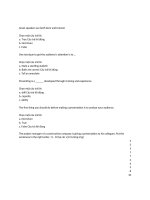Môn kỹ năng thuyết trình EN54 healthy lifestyle (8 điểm)
Bạn đang xem bản rút gọn của tài liệu. Xem và tải ngay bản đầy đủ của tài liệu tại đây (1.47 MB, 28 trang )
HEALTHY
LIFESTYLE
DR: NGUYỄN THỊ HỊA BÌNH
Dong Nai hospital
DR NGUYỄN THỊ HỊA
BÌNH
DONGNAI HOSPITAL
Aims of the presentation
• To inform and discuss what a ‘healthy lifestyle’ means
• To help you identify health behaviours you could incorporate
into your lifestyle
• To answer your questions on a healthy lifestyle
What’s a healthy lifestyle?
• Health: the state of being from illness or injury ( person’s
mental or physical condition)
• Style: a particular procedure by which something is done, a
manner or way
• Lifestyle: the way in which a personal live
• Health is a combination these 3 components:
WELLNESS TRIANGLE
PHYSICAL
HEALTH
COMPLETE
WELLNESS
SOCIAL HEALTH
MENTAL
HEALTH
Mental health
• Like, accept, feel good about yourself
• How well you relate to others
• How you meet the demands of daily life
Social heath
• The way you get along with others
• Your ability to make and keep frineds
• Work and play in cooperative ways
• Communicating well and sharing your feelings with others
Physical health
• All parts of the system of the body work togethers
• Withstands the stressers of normal everyday life
• Having strength and energy to pursue energy physical, mental
and emotional and social challenges and changes
• Some researchers termed the following
the holy 4 as they have a big impact on
disease:
Smoking
Drinking
Nutrition
Physical Activity
Smoking
• Don't smoke, and quit if you do.
• Ask your health care provider for help.
• UCSF offers a smoking cessation program.
Watch the Scotch!
• Men: 3-4 units/day
• Women: 2-3 units/day
• 2 Alcohol-free days a week
• Can’t save units up and binge
• Common drinks and their units;
• Pint normal strength beer: 2 units
ã 175ml glass (medium) wine: 1 ẵ - 2 units
ã Alcopop: 1 ẵ units
ã Pub measure of spirit: 1 unit
ã Be aware of home measures and calorie content of alcohol
Exercise can be a walk in the park!
• A 30 minute
Brisk walk
Jogging
Cycling
Heavy gardening/housework
…on >5 days a week
• If it gets you slightly out of breath and a bit sweaty its working!
• Two 15 minute bursts may be just as effective
Nourish Yourself!
• The next section will discuss ways in which a healthy diet is achievable;
• Based on current guidelines
• Evidence based
• Cover a wide range of aspects of a healthy diet
Think of your body as a car; you wouldn’t fuel your petrol car with diesel
(on purpose!)
Why 5 a Day?
400g fruit and vegetables a day can help us to stay
healthy
• Great source of antioxidants, vitamins and minerals
• Make a good healthy, handy and sometimes cheap
snack i.e. banana 19p!
• Help to prevent constipation due to their high
dietary fibre content
• May reduce risk of cancer, heart disease and stroke
What
Fresh
Counts?
Frozen
Tinned
Canned
Dried
Shows a product
contains a number
of 5 a day
www.dh.gov.uk
Carbohydrates
Q: What are they?
A: Sugars and starches that provide our bodies with energy (calories) to function
Dietary sources come in two forms;
• Simple
• Fructose (fruit sugar), sucrose (table sugar), lactose (milk sugar) and
glucose
• Sweets, sugary pop
• Complex/starchy
• Bread, flour, rice, pasta, breakfast cereals
• Good source of calcium, iron and B vitamins
• Fruit and vegetables and pulses also provide carbohydrates; a
mixture of starches and sugars
Recommended dietary intake: 33% starchy carbs, 50% total carbs
• Our bodies store unused carbohydrate in the liver and muscles but
when full, excess carbohydrate is stored as fat
• Too little carbs weakness, poor concentration (not enough fuel to
the brain), constipation
Q: Are carbohydrates fattening?
A: Gram for gram carbohydrates contain less than half as many calories as
fat.
• Cooking methods affect the calorie content of carbohydrate foods, as does adding fats and oils to taste
Q: What about low carbohydrate diets?
A: Low carbohydrate diets don’t represent each food group which may lead
to symptoms related to the imbalanced dietary intake. Our body quickly
moves from obtaining energy from fat stores onto digesting muscles
Wholegrains
• Wheat, barely, rye, oats and rice
• 3 layers;
• Fibre rich outer layer (bran)
• Nutrient packed inner area (germ)
• Central starchy part (endosperm)
•
Processing removes the bran and germ white variety
•
Surveys show 95% of adults don’t consume enough
•
Soluble & non-soluble fibre to prevent constipation, lower
cholesterol and encourage healthy gut bacteria
• May
risk of type 2 diabetes, heart disease and some cancers
• Aim for 3 servings daily
• Low ‘GI’ (slow release of energy) which may keep you fuller for longer
• Look out for ‘Whole’ before the name of the cereal
Ideas:
• Wholegrain cereals and cereal bars with yoghurt or milk for
breakfast or as snacks
• Wholemeal, granary, multigrain bread instead of white
• Oatmeal and whole-oats to make flapjack
• Quinoa, bulgur wheat, brown rice in salads or with curries









